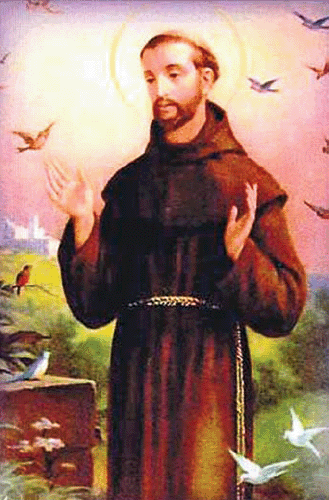ABSTRACT: One of the most important moments for all qualified veterinary nurses is the one when you pin your badge onto your uniform for the first time. But have you ever wondered who St Francis was and why he has been the central image on both your badge and the British Veterinary Nursing Association logo? The short answer is that St Francis of Assisi is the patron saint of animals, but his life story and the circumstances that led to his association with animals is a fascinating one.
As this year celebrates both 25 years of the VNJ, and the 50th anniversary of the VN qualification, I thought it would be interesting to explore the history of the saint whom the veterinary nursing profession has taken to its heart.
Childhood
One of seven children, St Francis was born Giovanni Francesco di Bernardone in either 1181 or 1182 – many sources state that the exact year is unknown. His parents were Pietro and Pica di Bernardone and his father, Pietro, was a wealthy cloth merchant in Assisi, Umbria, in Italy.
Pietro was away on business in France when Francesco was born, and on his return found that he had been baptised Giovanni after St John the Baptist, which he disliked, and so insisted on changing his name to Francesco, the English translation of which is Francis.

St Francis of Assisi
Early adult life
The renamed Francesco enjoyed a happy childhood – he enjoyed life to the full and had little time for formal learning at that time. His father provided him with rich clothing and money to spend.
As a young adult he was taken prisoner for a year after participating in a brief war between Assisi and neighbouring Perugia. His incarceration led to an illness from which he took some time to recover; but once he had regained full health, he joined a troop of knights who were journeying south to fight the Germans under the leadership of Walter de Brienne.
Sadly, Francesco was taken ill again, and it was during this time that he started to gain a spiritual insight and began reflecting on his past life. It is reported that at this point he also heard a voice telling him to turn back, and “to serve the Master rather than the man”. Francis obeyed this voice and returned to Assisi.
He then spent some years travelling around the wilder regions of Umbria, and during his sojourn he met with people far less fortunate than himself. One of these was a leper, and in those days this was a common disease that was much feared. It was this meeting that led him to visit hospitals and leper refuges.
Francesco also went on a pilgrimage to Rome, where he reportedly emptied his purse and gave everything he had to the beggars in the city. It is thought that he also swapped clothes with a beggar, and for the remainder of the day, experienced life as a poor person, begging outside St Peter’s Tomb in Rome.
Religious life
He returned to Umbria, and continued to carry out his work for the church and the poor in the town of Foligno, much to the anger and disappointment of his father, who insisted that he return home. His father even beat him and had him summoned to trial, for ‘wasting money’ on the church and the poor.
The rift between Francesco and his father widened and there was an eventual parting of ways. Sources differ, some say that he was forced to return all his remaining inherited wealth to his father and was disinherited, whilst others report that Francesco voluntarily renounced his father and his wealth.
Francesco returned to wandering the countryside of Umbria, helping to restore many churches. During this time he gained a number of followers, including Bernado di Quintavalle and Peter de Cattaneo, who all lived a simple life preaching to locals and helping them with their work in the fields.
In 1209, the group travelled to Rome to seek permission from Pope Innocent III, to found a new religious order – The Order of Friars Minor. The Pope was hesitant at first, but the Bishop of Assisi, Cardinal John Colonna, pleaded on their behalf, and the Pope finally gave his permission and Francesco was duly elected as the leader of the Order.
The friars returned to Umbria and continued their work, gaining many followers and supporters. One of the most notable being Chiara Offreduccio, later known as St Clare of Assisi, who became a follower of Francesco, and who set up the Order of Poor Ladies later known as the Order of Saint Clare, in her honour, 10 years after her death.
Over the next few years Francesco and his brothers travelled around Italy, and even to Egypt, to strengthen their Order and spread the word. Francesco is reported to have been the instigator of the first ‘live’ nativity scene for Christmas in 1220.
The animal connection
Francesco’s love of animals and nature has been well documented. In 1224, he composed the famous poem ‘The Canticle of the Sun’ to thank God for creating animals and the nature around them.
Once he preached to the birds. His sermon began: “My little sisters, the birds, you owe much to God, your Creator, and always in every place ought you to praise him because he has given you the liberty to fly everywhere.” While he spoke, ‘these birds began all of them to open their beaks and stretch their necks and spread their wings and bend their heads close to the ground’.
Several legends have been created about Francesco and his love of animals. Although they appear far-fetched to our modern eyes and ears, they should be viewed in the context of the 13th century when life was very simple and miracles were accepted at face value. One that caught my eye concerned a wolf that terrorised the people of Gubbio.
On hearing this, Francesco took pity on the people of the town, and went into the hills to look for the wolf. When he came face to face with the snarling beast, Francesco drew a sign of the cross in the air and commanded the wolf to approach him. It did just that and lay at his feet. He took the animal into the town and told the townsfolk that if they fed it, the wolf would never attck anyone.
He then blessed the wolf to reassure the people of Gubbio that it would no longer harm them.
It was also said that on his deathbed, Francesco thanked his donkey for “carrying and helping him throughout his life” and that on hearing this, the donkey wept!
Later life
It was also in 1224 that Francesco is said to have experienced stigmata. These are wounds that resemble those that were inflicted on Christ during the crucifixion. On or about Holy Cross Day – 14th September – at sunrise, after a night of prayer, he had a vision of a winged seraph or angel, nailed to a cross, flying towards him. He also felt keen stabs of pain in his hands, feet and sides. The vision vanished, and he discovered the stigmata of the crucified Christ on his body.
As he grew older, Francesco’s health began to fail and he longed to go home to Assisi. On 3rd October 1226, Francesco died in his bed in Assisi after having his poem ‘The Canticle of the Sun’ read to him by the brothers of the Order earlier that day.
Two years later, Pope Gregory IX made him a Saint and laid the first stone of the Basilica of St Francis in Assisi, in his honour. In 1230, the remains of St Francis were transferred to the completed Basilica where they still lie today albeit in a glass urn, after having been formally identified in 1978 b
y a group of scholars appointed by Pope Paul VI.
The image of St Francis has always been used for our veterinary nursing badge and for the BVNA. The original logo featuring St Francis was first seen on the newly designed newsletter in February 1977.
So, now you know a little more about the life of St Francis of Assisi, the saint who exemplifies the primary aim of the veterinary nursing profession – to help and care for animals.
Author
Claire Fraser rvn mbvna

Claire qualified in 1990 and spent many years in general small animal practice. Since September 2006, she has worked as a full-time Internal Verifier for MYF Training, but does still spend some time in practice, to keep her nursing skills current. She has also been a member of the BVNA Council since 2003 and was the Association's president in 2007/2008.
She has a particular interest in medical nursing, especially feline medical diseases.
Veterinary Nursing Journal • VOL 25 • Noll • November 2010 •